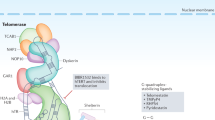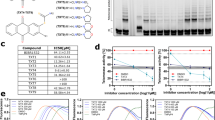Abstract
Telomere maintenance is essential for cancer growth. Induction of telomere dysfunction, for example, by inhibition of telomeric proteins or telomerase, has been shown to strongly enhance cancer cells’ sensitivity to chemotherapies. However, it is not clear whether modulations of telomere maintenance constitute cancer cellular responses to chemotherapies. Furthermore, the manner in which anti-cancer drugs affect telomere function remains unknown. In this study, we show that anthracyclines, a class of anti-cancer drugs widely used in clinical cancer treatments, have an active role in triggering telomere dysfunction specifically in telomerase-positive cancer cells. Anthracyclines interrupt telomere maintenance by telomerase through the downregulation of PinX1, a protein factor responsible for targeting telomerase onto telomeres, thereby inhibiting telomerase association with telomeres. We further demonstrate that anthracyclines downregulate PinX1 by inducing this protein degradation through the ubiquitin–proteasome-dependent pathway. Our data not only reveal a novel action for anthracyclines as telomerase functional inhibitors but also provide a clue for the development of novel anti-cancer drugs based on telomerase/telomere targeting, which is actively investigated by many current studies.
This is a preview of subscription content, access via your institution
Access options
Subscribe to this journal
Receive 50 print issues and online access
$259.00 per year
only $5.18 per issue
Buy this article
- Purchase on Springer Link
- Instant access to full article PDF
Prices may be subject to local taxes which are calculated during checkout





Similar content being viewed by others
References
Akiyama Y, Maesawa C, Wada K, Fujisawa K, Itabashi T, Noda Y et al. (2004). Human PinX1, a potent telomerase inhibitor, is not involved in human gastrointestinal tract carcinoma. Oncol Rep 11: 871–874.
Autexier C, Greider CW . (1996). Telomerase and cancer: revisiting the telomere hypothesis. Trends Biochem Sci 21: 387–391.
Bianchi A, Shore D . (2008). How telomerase reaches its end: mechanism of telomerase regulation by the telomeric complex. Mol Cell 31: 153–165.
Blackburn EH . (2000). Telomere states and cell fates. Nature 408: 53–56.
Chang Q, Pang JC, Li J, Hu L, Kong X, Ng HK . (2004). Molecular analysis of PinX1 in medulloblastomas. Int J Cancer 109: 309–314.
Collins K . (2000). Mammalian telomeres and telomerase. Curr Opin Cell Biol 12: 378–383.
Collins K . (2006). The biogenesis and regulation of telomerase holoenzymes. Nat Rev Mol Cell Biol 7: 484–494.
Cong YS, Wright WE, Shay JW . (2002). Human telomerase and its regulation. Microbiol Mol Biol Rev 66: 407–425.
De Lange T . (1998). Telomeres and senescence: ending the debate. Science 279: 334–335.
de Lange T . (2005). Shelterin: the protein complex that shapes and safeguards human telomeres. Genes Dev 19: 2100–2110.
Denchi EL, de Lange T . (2007). Protection of telomeres through independent control of ATM and ATR by TRF2 and POT1. Nature 448: 1068–1071.
Gallardo F, Olivier C, Dandjinou AT, Wellinger RJ, Chartrand P . (2008). TLC1 RNA nucleo-cytoplasmic trafficking links telomerase biogenesis to its recruitment to telomeres. EMBO J 27: 748–757.
Goueli BS, Janknecht R . (2004). Upregulation of the catalytic telomerase subunit by the transcription factor ER81 and oncogenic HER2/Neu, Ras, or Raf. Mol Cell Biol 24: 25–35.
Harley CB . (2008). Telomerase and cancer therapeutics. Nat Rev Cancer 8: 167–179.
Hawkins GA, Chang BL, Zheng SL, Isaacs SD, Wiley KE, Bleecker ER et al. (2004). Mutational analysis of PINX1 in hereditary prostate cancer. Prostate 60: 298–302.
Kim NW, Piatyszek MA, Prowse KR, Harley CB, West MD, Ho PL et al. (1994). Specific association of human telomerase activity with immortal cells and cancer. Science 266: 2011–2015.
Laurent G, Jaffrezou JP . (2001). Signaling pathways activated by daunorubicin. Blood 98: 913–924.
Lin SY, Elledge SJ . (2003). Multiple tumor suppressor pathways negatively regulate telomerase. Cell 113: 881–889.
Liu Y, Snow BE, Hande MP, Yeung D, Erdmann NJ, Wakeham A et al. (2000). The telomerase reverse transcriptase is limiting and necessary for telomerase function in vivo. Curr Biol 10: 1459–1462.
Mergny JL, Helene C . (1998). G-quadruplex DNA: a target for drug design. Nat Med 4: 1366–1367.
Meyerson M, Counter CM, Eaton EN, Ellisen LW, Steiner P, Caddle SD et al. (1997). hEST2, the putative human telomerase catalytic subunit gene, is up-regulated in tumor cells and during immortalization. Cell 90: 785–795.
Minotti G, Menna P, Salvatorelli E, Cairo G, Gianni L . (2004). Anthracyclines: molecular advances and pharmacologic developments in antitumor activity and cardiotoxicity. Pharmacol Rev 56: 185–229.
Nakamura M, Masutomi K, Kyo S, Hashimoto M, Maida Y, Kanaya T et al. (2005). Efficient inhibition of human telomerase reverse transcriptase expression by RNA interference sensitizes cancer cells to ionizing radiation and chemotherapy. Hum Gene Ther 16: 859–868.
Nugent CI, Lundblad V . (1998). The telomerase reverse transcriptase: components and regulation. Genes Dev 12: 1073–1085.
Palm W, de Lange T . (2008). How shelterin protects mammalian telomeres. Annu Rev Genet 42: 301–334.
Shay JW, Wright WE . (2006). Telomerase therapeutics for cancer: challenges and new directions. Nat Rev Drug Discov 5: 577–584.
Small GW, Somasundaram S, Moore DT, Shi YY, Orlowski RZ . (2003). Repression of mitogen-activated protein kinase (MAPK) phosphatase-1 by anthracyclines contributes to their antiapoptotic activation of p44/42-MAPK. J Pharmacol Exp Ther 307: 861–869.
Takai H, Smogorzewska A, de Lange T . (2003). DNA damage foci at dysfunctional telomeres. Curr Biol 13: 1549–1556.
Tomlinson RL, Ziegler TD, Supakorndej T, Terns RM, Terns MP . (2006). Cell cycle-regulated trafficking of human telomerase to telomeres. Mol Biol Cell 17: 955–965.
Uziel O, Beery E, Dronichev V, Samocha K, Gryaznov S, Weiss L et al. (2010). Telomere shortening sensitizes cancer cells to selected cytotoxic agents: in vitro and in vivo studies and putative mechanisms. PLoS One 5: e9132.
Wang C, Yu J, Yuan K, Lan J, Jin C, Huang H . (2010). Plk1-mediated mitotic phosphorylation of PinX1 regulates its stability. Eur J Cell Biol 89: 748–756.
Wong JMY, Kusdra L, Collins K . (2002). Subnuclear shuttling of human telomerase induced by transformation and DNA damage. Nat Cell Biol 4: 731–736.
Xin H, Liu D, Wan M, Safari A, Kim H, Sun W et al. (2007). TPP1 is a homologue of ciliate TEBP-β and interacts with POT1 to recruit telomerase. Nature 445: 559–562.
Zhang B, Bai YX, Ma HH, Feng F, Jin R, Wang ZL et al. (2009). Silencing PinX1 compromises telomere length maintenance as well as tumorigenicity in telomerase-positive human cancer cells. Cancer Res 69: 75.
Zhou XZ, Lu KP . (2001). The Pin2/TRF1-interacting protein PinX1 is a potent telomerase inhibitor. Cell 107: 347–359.
Acknowledgements
This work is supported by grants from the Chinese NSFC (30901769), Guangdong National Science Foundation (9451008901002371) and the China Postdoctoral Science Foundation (20090450900) to B Zhang, and also partially by grants from the National Basic Research Program (973 program) of China (No. 2010CB912802) to H-F Kung and (No. 2010CB529404) to J-J Huang, the Chinese NSFC (30771074) to H Zhang.
Author information
Authors and Affiliations
Corresponding authors
Ethics declarations
Competing interests
The authors declare no conflict of interest.
Rights and permissions
About this article
Cite this article
Zhang, B., Qian, D., Ma, HH. et al. Anthracyclines disrupt telomere maintenance by telomerase through inducing PinX1 ubiquitination and degradation. Oncogene 31, 1–12 (2012). https://doi.org/10.1038/onc.2011.214
Received:
Revised:
Accepted:
Published:
Issue Date:
DOI: https://doi.org/10.1038/onc.2011.214
Keywords
This article is cited by
-
Combining old and new concepts in targeting telomerase for cancer therapy: transient, immediate, complete and combinatory attack (TICCA)
Cancer Cell International (2023)
-
The depletion of PinX1 involved in the tumorigenesis of non-small cell lung cancer promotes cell proliferation via p15/cyclin D1 pathway
Molecular Cancer (2017)
-
Nucleophosmin Interacts with PIN2/TERF1-interacting Telomerase Inhibitor 1 (PinX1) and Attenuates the PinX1 Inhibition on Telomerase Activity
Scientific Reports (2017)
-
PinX1 inhibits cell proliferation, migration and invasion in glioma cells
Medical Oncology (2015)
-
Gene expression levels of human shelterin complex and shelterin-associated factors regulated by the topoisomerase II inhibitors doxorubicin and etoposide in human cultured cells
Tumor Biology (2013)



